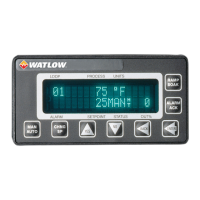CLS200 Series User’s Guide
Chapter 1: System Overview
14
• Independently Selectable Control and Output Modes: You can set each control output
to on/off, time proportioning, Serial DAC (digital-to-analog converter), or distributed zero
crossing mode. Set up to two outputs per loop for on/off, P, PI or PID control with reverse or
direct action.
• Control Outputs: Set high/low deviation and high/ low process limits to operate digital
outputs as on/off control functions or alarms.
• Flexible Alarm Outputs: Independently set high/ low process alarms and a high/low
deviation band alarm for each loop. Alarms can activate a digital output by themselves, or
they can be grouped with other alarms to activate an output.
• Global Alarm Output: When any alarm is triggered, the global alarm output is also triggered,
and it stays on until you acknowledge it.
• CPU Watchdog: The CLS200 series CPU watchdog timer output notifies you of system
failure. Use it to hold a relay closed while the controller is running, so you are notified if the
microprocessor shuts down.
• Front Panel or Computer Operation: Set up and run the controller from the front panel or
from a local or remote computer. Watlow
®
offers SpecView, a Windows
®
compatible Human
Machine Interface (HMI) software package that includes data logging and graphing features in
addition to process monitoring.
• Modbus
®
RTU Protocol, EIA/TIA-232 and 485 Communications: Connect to PLCs,
operator interface terminals and third-party software packages using the widely supported
Modbus
®
RTU protocol.
• Multiple Job Storage: Store up to eight jobs in memory, and access them locally by
entering a single job number or remotely via digital inputs. Each job is a set of operating
conditions, including setpoints and alarms.
• Nonlinear Output Curves: Select either of two non-linear output curves for each control
output.
• Autotuning: Use the autotune feature to set up your system quickly and easily.
• Pulse Counter Input: Use the pulse counter input for precise control of motor or belt speed.
• Low Power Shutdown: The controller shuts down and turns off all outputs when it detects
the input voltage drop below the minimum safe operating level.

